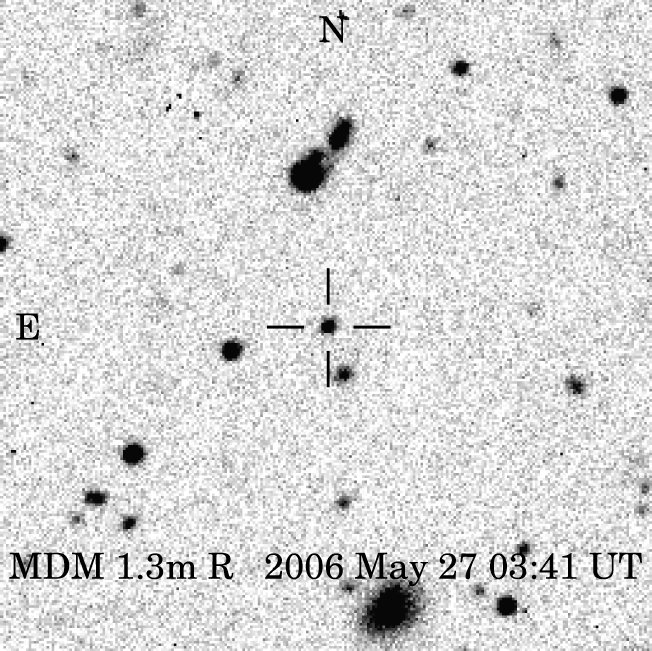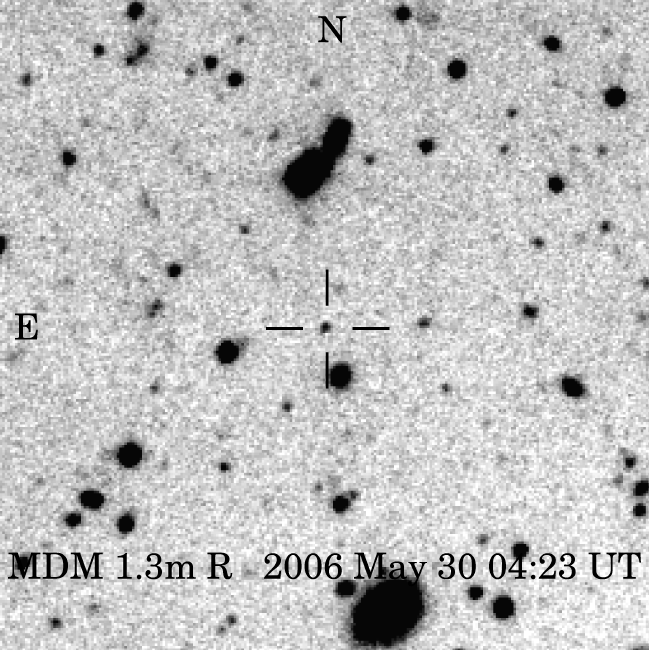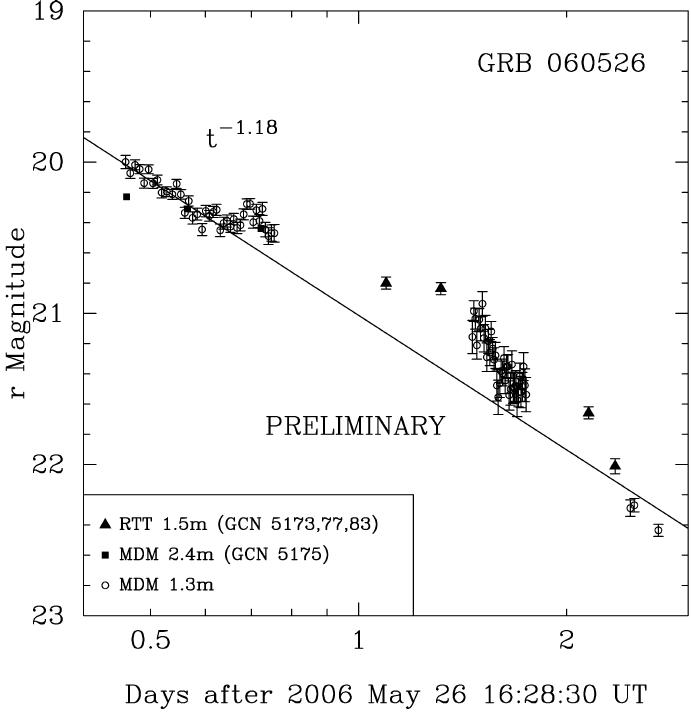 | |
 | |
 |

|
| GRB 060526: Optical follow-up |
| GCN Circular #5175
GRB 060526: MDM-2.4m Observations |
N. D. Morgan and X. Dai (Ohio State Univ.) We observed GRB 060526 (GCN 5162, Campana et al. 2006) with MDM-2.4m for three epochs. The afterglow is detected in all three observations. Using USNO B-1 star as the reference (RA=15:31:18.6, DEC=+00 17 34.9, R2MAG=16.35, same one used in GCN5173 Khamitov et al. 2006), we get Rc = 19.90 @ May 27, 03:33:00 UT Rc = 19.98 @ May 27, 06:02:00 UT Rc = 20.11 @ May 27, 09:49:00 UT This message may be cited. |
| GCN Circular #5176
GRB 060526: Optical Flare |
J. P. Halpern (Columbia U.), E. Armstrong (UCSD), & N. Mirabal (U. Michigan) report on behalf of the MDM Observatory GRB follow-up team: "Using the MDM 1.3m telescope on Kitt Peak, we obtained a continuous R-band time series of the afterglow of Swift GRB 060526 (Campana et al. GCN 5162), consisting of 40 10-minute exposures, from 11.0 to 18.2 hours after the burst. Preliminary photometry was performed using comparison stars in r' from the SDSS calibration (Cool et al. GCN 5164). In addition, wherever possible, we placed other GCN reported R-band photometry (Covino et al. GCN 5167; Khamitov et al. GCN 5173; Morgan & Dai GCN 5175) on a common scale using the SDSS r' magnitudes of their indicated comparison stars. As a result, we find that a power-law decay index of -1.18 +/- 0.05 fitted to the Khamitov et al. data alone from 5.6 to 8.9 hours also fits the MDM light curve very well, until about 16 hours after the burst. At that time, a flare began that had a rise time of about 40 minutes, followed by a slower decay, and had not yet returned to the extrapolated power law when the observations were terminated at twilight. The peak of the flare occurred around May 27 09:06 UT, and reached about 0.3 magnitudes above the extrapolation. In combination with the multiple episodes of gamma-ray and X-ray emission (Campana et al. GCNs 5163, 5168; Markwardt et al. GCN 5174) and the long plateau in the early optical light curve (Rykoff et al. GCN 5166), these results indicate the possibility of extended and complex activity from GRB 060526 that warrants intensive monitoring. A preliminary version of the MDM optical light curve and incorporated GCN data is available at http://www.astro.columbia.edu/~jules/grb/060526/ The data contained in the figure are not yet suitable for publication." |
| (J2000) 15h 31m 18.36s, +00° 17′ 04.9″ (2.2′ × 2.2′) |

|

|
| GCN Circular #5188
GRB 060526: Multiple Optical Flares |
J. P. Halpern (Columbia U.), E. Armstrong (UCSD), & N. Mirabal (U. Michigan) report on behalf of the MDM Observatory GRB follow-up team: "We have continued to observe the afterglow of Swift GRB 060526 (Campana et al. GCN 5162) in the R-band for four consecutive nights using the MDM 1.3m. In combination with the GCN reported R-band photometry of Khamitov et al. (GCNs 5173,5177,5183,5186), it is evident that there have been at least four flares, by which we mean alternating positive and negative deviations from a mean decay rate. These are characterized as increases and decreases of at least 0.3 mag in as short a time as delta t = 0.04*(t-t0), where t0 is the burst time. In view of these flares, it is problematic to fit a small number of power-law segments (as noted by Kann & Thoene GCN 5187). Rather, we observe that the most recent point, r' = 22.87+/-0.07 on May 30 04:23 UT as calibrated with Cool et al. (GCN 5164) data, falls only 0.25 mag below the -1.18 power law originally fitted from 5.6 to 16 hours by Khamitov et al. (GCN 5173) and Halpern et al. (GCN 5176). Other details of the MDM optical light curve and incorporated GCN data can be seen at: http://www.astro.columbia.edu/~jules/grb/060526/ This type of light curve is not uncommon in GRB afterglows (see, e.g., Stanek et al. astro-ph/0602495, and references therein), and is often apparent when the source is well placed for long observing runs at ground-based telescopes." |
This decay curve is preliminary, not for
publication.

|

|
|
Eve Armstrong earmstrong@physics.ucsd.edu |
|
|
Nick Morgan nmorgan@astronomy.ohio-state.edu |
Xinyu Dai xinyu@astronomy.ohio-state.edu |
|
Jules Halpern jules@astro.columbia.edu |
Nestor Mirabal mirabal@umich.edu |
| Back to the main MDM GRB page | |
| Last Modified: June 1, 2006 | jules@astro.columbia.edu |
